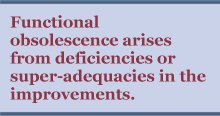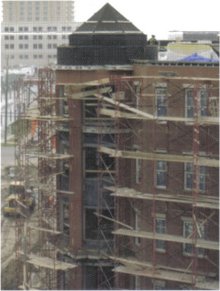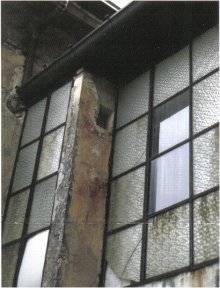

|
207 Abbey Lane Lansdale, Pennsylvania 19446 215-855-1800 |
5201 Ocean Avenue #2007 Wildwood, New Jersey 08260 215-990-6663 |
Specializing in Real Estate Appraisal and Property Tax Consulting
A Professional Courtesy of:
|

Specializing in Real Estate Appraisal and Property Tax Consulting |
| SPRING 2009 |
 |
|
In This Issue: |
|
Statistical Analysis in Valuation The use of statistics in real estate valuation has become increasingly important. Statistics "involves collecting, classifying, summarizing, organizing, analyzing, and interpreting numerical information" (The Appraisal of Real Estate, 13th Edition); Although many practitioners and users of appraisals may blanch at the mere mention of statistics, a practical understanding of statistics will become increasingly important. The fact that statistics is not intuitive further complicates its acceptance by many.Statistics is broadly categorized into descriptive statistics and inferential statistics. Descriptive statistics are used to characterize a sample or a population of specific data. For example, an array of data points may be shown in a scatter plot in relation to values on both the x (horizontal) and y (vertical) axes. Histograms are used to compare data such as sale price per square foot or expenses per square foot. Inferential statistics use data to predict outcomes, define measures of central tendency, measure dispersion and explain the underlying structure of casual relationships. Commonly used measures of central tendency are the mean, median, geometric mean and mode. Measures of dispersion are the standard deviation and variance, coefficient of variation, range and interquartile range. The underlying structure of the data, termed "shape," is measured by kurtosis and normality. Regression is a powerful predictive tool in valuation, assuming adequate data and knowledge by the appraiser. Regression analysis is a mathematical equation that quantifies the relationship between a dependent variable (e.g., rent and price or value) and one or more independent variables (e.g., size, age and condition, location, date of sale). When only one independent variable is used, the model is termed linear regression. If more than one independent variable is used, the model is called multiple linear regression. Property tax assessors have long used multiple linear regression to derive assessed values. This is a particularly good tool for such work, because the assessor must estimate the value of thousands or hundreds of thousands of parcels. There are certain assumptions underlying any regression model, specifically,
In practical terms, statistical analyses are found in automated valuation models (AVMs) and in custom valuation models (CVMs). AVMs are used by some residential lenders to predict the sale price of a property for underwriting purposes. Many AVMs currently exist and more are being introduced. CVMs are used in property tax assessment and equity analyses, price and rent trend analyses, impact studies addressing noxious or hazardous influences, and litigation support work. Despite the increased use of statistics in valuation, there are some disadvantages to the practice. For instance, there is always the chance that statistical methods may be misused, due to either intentional attempts to mislead or to a lack of understanding of the models being used. Another disadvantage of statistical usage, particularly in litigation, is that the fundamentals of statistics are not well known, so it is a challenge for juries and the courts to understand the methodologies being presented and to form an opinion regarding the credibility of such evidence. Nonetheless, statistics is likely to be increasingly used as a valuation tool. Indeed, many future advances in real estate valuation are likely to involve statistical methodology. Providers of real estate appraisal education will almost surely increase, the available curriculum in applied statistics while developing better methods of explanation. |
Forms of Depreciation Depreciation affects all improved real estate, with the possible exception of new improvements. There are 3 forms of depreciation: physical deterioration, functional obsolescence and external obsolescence. Physical deterioration, the wearing away of the physical property, occurs as improvements age. The rate of deterioration varies according to the quality of the improvements, the degree of maintenance performed and the time period in question. Deterioration does not occur at a constant annual rate but typically accelerates in later years.
Physical deterioration, the wearing away of the physical property, occurs as improvements age. The rate of deterioration varies according to the quality of the improvements, the degree of maintenance performed and the time period in question. Deterioration does not occur at a constant annual rate but typically accelerates in later years.Physical deterioration may be classified as curable or incurable. Curable deterioration is referred to as deferred maintenance (i.e., normal maintenance that has not been performed). It is termed curable because the cost to cure is equal to or less than the value contribution of such maintenance. Incurable deterioration is that which is not economically feasible to correct currently (i.e., the cost to cure is greater than the value contribution of same). Physical incurable deterioration may be further broken down into short-lived and long-lived items. Short-lived items are those likely to require replacement in the short term. Examples are such items as paint, floor coverings and roofs. Long-lived items are often structural in nature, such as foundations, exterior walls and insulation. These items are typically not replaced during the economic life of the improvements, but they do deteriorate over time.  One means of measuring physical deterioration is the modified age/life method, defined as "a method of estimating depreciation in which the ratio between the effective age of a building and its total economic life is applied to the current cost of the improvements to obtain a lump-sum deduction...." (The Dictionary of Real Estate Appraisal, Fourth Edition).
One means of measuring physical deterioration is the modified age/life method, defined as "a method of estimating depreciation in which the ratio between the effective age of a building and its total economic life is applied to the current cost of the improvements to obtain a lump-sum deduction...." (The Dictionary of Real Estate Appraisal, Fourth Edition).Functional obsolescence arises from deficiencies or super-adequacies in the improvements. A multi-story office building without restrooms on each floor would likely have functional obsolescence. Similarly, an office building or warehouse with a 12-inch-thick foundation would likely be subject to functional obsolescence due to super-adequacy (that is, the added cost of constructing such a foundation would not be reflected in value). As with physical deterioration, functional obsolescence may be either curable or incurable, depending on the relationship between cost and value. The third form of depreciation is termed external obsolescence, so named because the source of the obsolescence is extrinsic to the property. External obsolescence is incurable in all cases. An example of external obsolescence is the adjacency of a chemical plant emitting noxious odors to the subject (e.g., a Class A apartment complex). Another example is a severely overbuilt submarket, resulting in decreased rental rates and increased occupancy. In such a case, the obsolescence may he of a short term, that is, until supply and demand are in equilibrium. In the former example, the obsolescence is a long-term factor. It is important to note that in no instance is land affected by aforementioned types of depreciation. Rather, land is valued by comparison with similar tracts that have sold. Its value reflects the impact of all factors, both positive and negative. There are other methods of estimating depreciation, specifically the market abstraction and breakdown methods. A description of each is beyond the scope of this newsletter. |
Economic Life, Effective Age and Remaining Economic Life There is an old adage that more buildings are torn down than fall down. This is true and adds to the importance of understanding the concepts of economic life, effective age and remaining economic life. Otherwise, depreciation can be estimated neither accurately nor allocated among the causes of such depreciation (i.e., physical deterioration, functional obsolescence and external obsolescence). Economic life is "the period over which improvements contribute to property value" (The Dictionary of Real Estate Appraisal, Fourth Edition). Other terms closely associated with economic life are "effective age" and "remaining economic life." The sum of the latter two is economic life.
Economic life is "the period over which improvements contribute to property value" (The Dictionary of Real Estate Appraisal, Fourth Edition). Other terms closely associated with economic life are "effective age" and "remaining economic life." The sum of the latter two is economic life.Effective age is a measure of the condition and functionality of improvements. If a building is actually 10 years old but compares closely with otherwise similar 5-year-old buildings, the effective age of the former is likely to be 5 years old. Conversely, buildings that have been poorly maintained or have significant functional problems may well have effective ages greater than their actual ages.  Remaining economic life is that period of years over which the improvements can be expected to serve the purpose for which they were designed. It may be affected by the physical condition of the improvements, the extent to which the building serves the needs of users and the influence of nearby uses, positive or negative. Effective age may be decreased and remaining economic life increased by extraordinarily good maintenance, renovation or both.
Remaining economic life is that period of years over which the improvements can be expected to serve the purpose for which they were designed. It may be affected by the physical condition of the improvements, the extent to which the building serves the needs of users and the influence of nearby uses, positive or negative. Effective age may be decreased and remaining economic life increased by extraordinarily good maintenance, renovation or both.These three concepts (economic life, remaining economic life and effective age) are inextricably interrelated to the concept of highest and best use. It is interesting to note that the economic life of improvements on a very expensive (and rapidly appreciating) site is likely to be considerably shorter than that of improvements on a low-priced site in a slow-growing area. In the case of the former, the period over which the improvements contribute value to the site as vacant is likely to be shortened as the site becomes more valuable. Remaining economic life takes on increased importance when it is relatively short. In the income capitalization approach, the use of direct capitalization will lead to erroneous results when remaining economic life is quite limited. Direct capitalization treats net income as lasting into perpetuity or at least for many years to come. Alternatively, the discounted cash flow technique allows for net income to be capitalized over the remaining economic life, with the present value of the reversion added thereto. |
Facade Easements The Dictionary of Real Estate Appraisal, Fourth Edition, defines a facade easement as "a restriction that prohibits the fee owner of a property from altering the facade or exterior of an existing improvement on his or her land; generally imposed on historically significant structures to ensure their preservation. A structure must be approved by the U.S. Department of the Interior through the National Park Service or registered as a National Historical Place before qualifying for a facade easement and receiving tax benefits." Facade easements are typically placed on the exteriors of architecturally significant structures to ensure long-term preservation. Such easements are legal agreements that prevent demolition, negligent maintenance and unsuitable alterations to the exteriors of the structures. The term of such agreements is in perpetuity. In return for entering into such easements, property owners receive federal income-, gift- and estate-tax benefits, if the easement is donated to a qualified 501(c)(3) organization, as defined by the Internal Revenue Service.
Facade easements are typically placed on the exteriors of architecturally significant structures to ensure long-term preservation. Such easements are legal agreements that prevent demolition, negligent maintenance and unsuitable alterations to the exteriors of the structures. The term of such agreements is in perpetuity. In return for entering into such easements, property owners receive federal income-, gift- and estate-tax benefits, if the easement is donated to a qualified 501(c)(3) organization, as defined by the Internal Revenue Service.Certain cities in the United States also purchase facade easements from building owners. By so doing, the dual purposes of preservation and public redevelopment incentives are served. This is often done in inner-city locations where redevelopment is not feasible without such incentives. An obvious key to such donations is the value of the facade easement. Real estate appraisers are called upon to provide such valuations. Clearly, facade easements are not transacted in the private-sector marketplace. Rather, the value of a facade easement is equal to the value of servient estate before and after the implementation of the easement. Due to perceived abuses, the IRS has been increasingly rigorous in analyzing deductions for facade easement donations. Appraisers must, therefore, take great care when preparing such valuations. Facade easements may or may not render the servient estate less valuable after donation. The servient interest (that which is encumbered by the easement) is likely to have diminished value if redevelopment is hindered or prohibited by the easement. Obviously, there must be current or reasonably proximate demand for such redevelopment in order for there to be a diminution in value due to lost potential. For example, a property representing highest and best use (as improved) in a blighted area with no realistic prospects for redevelopment in the near-to-intermediate term would probably not be negatively affected by a facade easement. That is, the owner of the property would not be deprived of the most profitable use of the property because of the facade easement. Deduction of the value of the facade easement for federal income tax purposes can be taken only once. Therefore, subsequent buyers of the property are not eligible for such tax advantages. In other words, the value of the facade easement accrues only to the donor of the easement. |
|
Next Issue: |
Home | Newsletters | About Us | Contact Us |